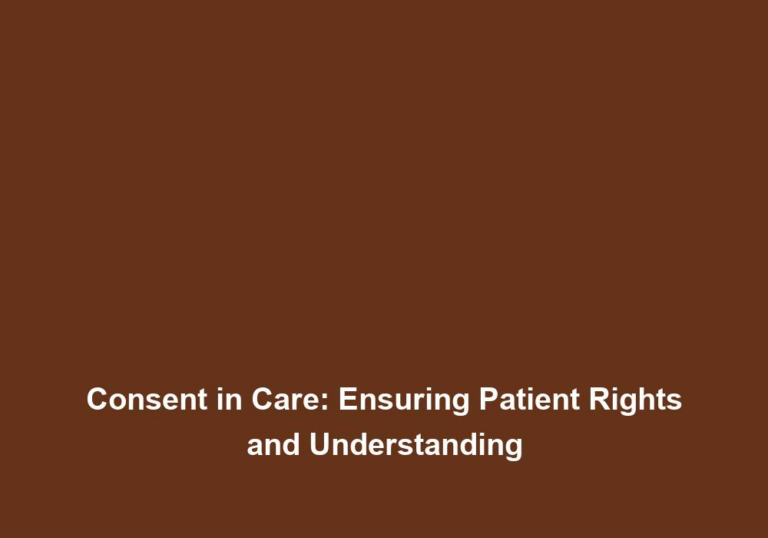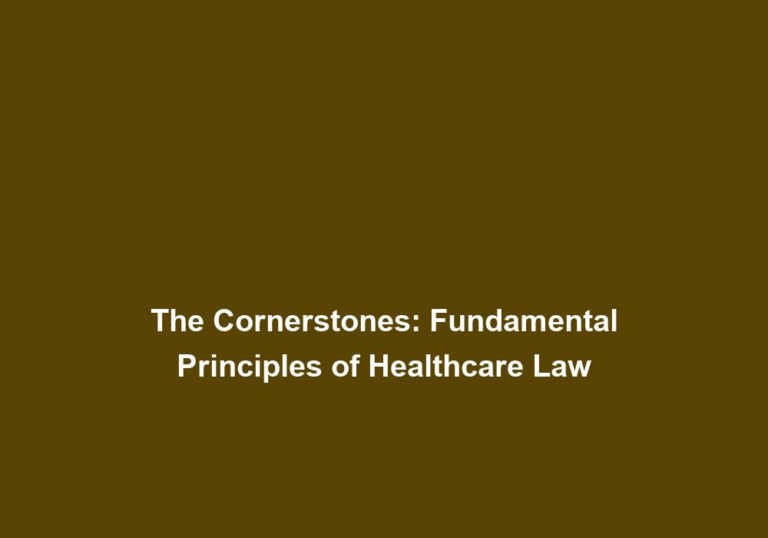Protecting the Patient: A Deep Dive into Rights and Confidentiality
In today’s rapidly evolving healthcare landscape, protecting the rights and confidentiality of patients is of utmost importance. As a healthcare provider or a professional working in the field, it is crucial to understand the significance of ensuring patient privacy and maintaining confidentiality. This article will delve into the various aspects of patient rights and confidentiality, providing a comprehensive understanding of this essential topic.
Understanding Patient Rights
Patient rights are fundamental principles that ensure individuals receive appropriate, ethical, and high-quality healthcare. These rights empower patients to play an active role in their healthcare decisions and safeguard their overall well-being. Let’s explore in more detail some key patient rights:
1. Right to Informed Consent
Patients have the right to be fully informed about their medical condition, potential treatment options, associated risks, and possible outcomes. Healthcare providers must ensure that patients understand the information provided and can make informed decisions about their care. Informed consent is a vital aspect of patient rights and is crucial for ethical medical practice.
Expanding on this, healthcare professionals should strive to provide information in a clear and understandable manner, avoiding medical jargon whenever possible. This allows patients to fully comprehend their medical condition and actively participate in their treatment decisions. Additionally, healthcare providers should encourage patients to ask questions and seek clarification to ensure their understanding.
To further support the right to informed consent, healthcare providers can provide educational materials, such as brochures or videos, that explain medical procedures and treatment options in a layperson’s terms. This empowers patients to make informed decisions by equipping them with the necessary knowledge to assess the risks and benefits of different treatment options.
2. Right to Privacy and Confidentiality
Protecting patient privacy and maintaining confidentiality is crucial to establish trust between healthcare providers and patients. This right ensures that a patient’s medical information remains secure and confidential, only accessible to authorized individuals involved in their care. Healthcare professionals must adhere to strict confidentiality guidelines outlined in laws like the Health Insurance Portability and Accountability Act (HIPAA) to protect patient information.
Expanding on this, healthcare organizations should implement robust policies and procedures to safeguard patient privacy. This includes securing physical documents and electronic health records (EHRs) through encryption and access controls. Additionally, healthcare providers should only share patient information on a need-to-know basis, ensuring that only authorized individuals involved in the patient’s care have access to their medical records.
It is also important for healthcare professionals to communicate the importance of patient privacy and confidentiality to their staff. This can be achieved through comprehensive training programs that cover topics such as handling sensitive information, proper use of EHR systems, and the consequences of breaching patient confidentiality. Regular refresher courses can help reinforce these principles and ensure that all staff members are up to date with the latest privacy protocols.
3. Right to Access Medical Records
Patients have the right to access their medical records, enabling them to review their health information, including diagnoses, treatment plans, and test results. This access allows patients to participate actively in their healthcare decisions, seek second opinions, and keep a comprehensive record of their medical history.
Expanding on this, healthcare providers should implement user-friendly systems that allow patients to easily access their medical records. This can be achieved through online portals or mobile applications that provide secure access to health information. By empowering patients with the ability to review their medical records, healthcare providers promote transparency and foster a collaborative approach to healthcare.
In addition to providing access to medical records, healthcare providers should also offer support and guidance to patients in interpreting and understanding their health information. This can be done through patient education materials, personalized explanations during consultations, or referrals to healthcare professionals who specialize in patient advocacy. By facilitating access to medical records and offering assistance in understanding them, healthcare providers empower patients to actively engage in their healthcare journey.
4. Right to Non-Discrimination
Every patient has the right to receive healthcare without facing discrimination based on race, color, religion, sex, age, disability, or any other protected characteristic. Healthcare providers must provide equal care and ensure that all patients have access to the same level of treatment and services, regardless of their background or personal attributes.
Expanding on this, healthcare organizations should implement policies and procedures that promote diversity, equity, and inclusion in all aspects of care delivery. This includes training healthcare providers and staff members on cultural competence, which involves understanding and respecting the diverse backgrounds and needs of patients.
To eliminate discrimination in healthcare, healthcare providers should also actively monitor and address any disparities in healthcare outcomes among different patient populations. This can be achieved through data collection and analysis, identifying areas where improvements are needed, and implementing targeted interventions to ensure equitable access and quality of care for all patients.
Ensuring Patient Confidentiality
Patient confidentiality is of paramount importance in healthcare settings. Healthcare providers must take rigorous measures to protect patient information from unauthorized access and ensure its confidentiality. Here are some key steps to safeguard patient confidentiality:
1. Implementing Secure Data Storage Systems
Healthcare organizations should invest in secure data storage systems that adhere to stringent privacy and security standards. These systems should employ encryption techniques, firewalls, and access controls to prevent unauthorized individuals from accessing patient information.
Expanding on this, healthcare organizations can also consider adopting cloud-based storage solutions that offer enhanced security features. These solutions often provide automatic backups, disaster recovery options, and advanced encryption methods to protect patient data from both internal and external threats.
Furthermore, it is crucial for healthcare organizations to regularly update their data storage systems and software to address any vulnerabilities or security flaws. This includes promptly applying security patches and utilizing intrusion detection systems to detect and respond to potential breaches.
2. Training Staff on Confidentiality Protocols
Healthcare professionals and staff members should receive comprehensive training on confidentiality protocols and the importance of patient privacy. This training should cover topics like handling sensitive information, proper use of electronic health record systems, and reporting any breaches or suspicious activities.
Expanding on this, healthcare organizations can conduct regular training sessions or workshops that focus on privacy and confidentiality best practices. These sessions should not only cover the technical aspects of protecting patient information but also emphasize the ethical and legal responsibilities associated with maintaining patient confidentiality.
Additionally, healthcare providers should establish clear guidelines and policies regarding the use of personal electronic devices in healthcare settings. Staff members should be educated on the risks associated with using personal devices for patient-related tasks and encouraged to adhere to organizational policies to ensure patient confidentiality.
3. Restricting Access to Patient Information
Healthcare organizations should implement strict access controls to limit the exposure of patient information to authorized individuals only. Access to patient records should be granted on a need-to-know basis, ensuring that healthcare providers can access the information necessary for patient care while maintaining confidentiality.
Expanding on this, healthcare providers should regularly review and update access privileges to ensure that only authorized individuals have access to patient information. This includes promptly revoking access for employees who no longer require it, such as staff members who have changed roles or left the organization.
Furthermore, healthcare organizations can implement two-factor authentication methods to add an extra layer of security to access controls. This requires users to provide additional verification, such as a unique code sent to their mobile device, before gaining access to patient records.
4. Regular Auditing and Monitoring
Periodic auditing and monitoring of data access and usage can help identify any security breaches or unauthorized access attempts promptly. This practice ensures that any potential threats or vulnerabilities are addressed, enhancing patient confidentiality.
Expanding on this, healthcare organizations should establish robust auditing mechanisms that track and log all access and activities related to patient information. This includes monitoring user logins, file access, and modifications made to patient records.
Additionally, healthcare organizations can implement real-time alert systems that notify administrators or IT personnel of any suspicious activities or unauthorized access attempts. These alerts can help facilitate immediate action to mitigate potential risks and prevent further breaches.
The Role of Technology in Protecting Patient Rights and Confidentiality
With the increasing adoption of technology in healthcare, it becomes essential to leverage innovative solutions to protect patient rights and confidentiality. Here are some ways technology can play a pivotal role:
1. Electronic Health Records (EHRs)
Electronic health records provide a secure and centralized platform for storing patient information. EHRs allow healthcare providers to access patient data efficiently while maintaining proper privacy and security measures. The use of EHRs reduces the reliance on paper-based records, minimizing the risk of unauthorized access or loss of physical documents.
Expanding on this, EHR systems can offer additional features, such as role-based access controls and audit trails, to enhance patient privacy and confidentiality. Role-based access controls ensure that healthcare providers can only access the information relevant to their role, while audit trails provide a detailed record of all activities performed within the EHR system.
Furthermore, healthcare organizations should prioritize interoperability between different EHR systems to facilitate secure information exchange while maintaining patient privacy. This allows healthcare providers to access relevant patient information from different healthcare organizations, ensuring continuity of care without compromising confidentiality.
2. Secure Communication Platforms
Technology facilitates secure communication channels, allowing healthcare professionals to exchange sensitive patient information securely. Encrypted messaging platforms and virtual private networks (VPNs) help ensure that patient data remains confidential during transmission.
Expanding on this, healthcare organizations should implement secure messaging platforms that encrypt all communication between healthcare providers. This prevents unauthorized individuals from intercepting or accessing patient information during transmission.
Additionally, healthcare providers should educate their staff on the proper use of secure communication platforms and emphasize the importance of encrypting patient information when communicating electronically. Regular reminders and training can help reinforce these practices and prevent accidental breaches of patient confidentiality.
3. Biometric Authentication
Implementing biometric authentication methods, such as fingerprint or iris scanning, adds an extra layer of security when accessing patient information. This technology helps prevent unauthorized access and ensures that only authorized individuals can view patient records.
Expanding on this, healthcare organizations can integrate biometric authentication into their access control systems, requiring healthcare providers to provide their unique biometric identifier, such as a fingerprint, to gain access to patient records. This significantly reduces the risk of password theft or unauthorized access through stolen credentials.
Furthermore, healthcare providers should regularly update and maintain biometric authentication systems to address any vulnerabilities or potential exploits. This includes ensuring that biometric templates are securely stored and encrypted to prevent unauthorized use.
4. Artificial Intelligence (AI) for Anomaly Detection
AI-powered systems can analyze vast amounts of data and detect any anomalies or suspicious activities that could indicate a breach in patient confidentiality. These systems can promptly alert healthcare providers of any potential threats, enabling them to take immediate action to protect patient privacy.
Expanding on this, AI algorithms can continuously monitor data access patterns, user behavior, and system logs to identify any unusual activities or deviations from normal usage. This proactive approach allows healthcare organizations to detect and respond to potential breaches before they escalate.
Additionally, AI-powered anomaly detection systems can help healthcare providers identify potential insider threats, such as employees accessing patient information without authorization. By analyzing patterns of access and detecting anomalies, these systems provide an extra layer of protection against internal breaches of patient confidentiality.
In conclusion, protecting the rights and confidentiality of patients is a crucial aspect of healthcare practice. By understanding and upholding patient rights, implementing strict confidentiality measures, and leveraging technology to enhance security, healthcare providers can ensure that patient privacy remains a top priority. By doing so, we can create a healthcare environment that fosters trust, promotes ethical practices, and provides the best possible care for patients.







